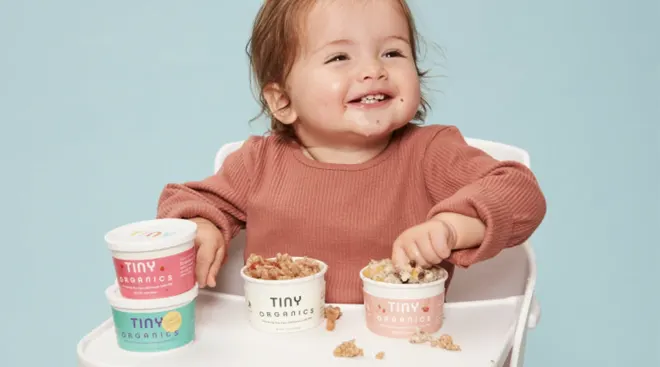The Dos and Don’ts of Homemade Baby Food
Your baby is entering an exciting new phase of development and is ready to eat solid foods. Many parents want to make homemade baby food, but struggle with where to start. Here we give you the top “Do’s and Don’ts” of introducing solids and making homemade baby food.
The American Academy of Pediatric’s (AAP) and the World Health Organization (WHO) both recommend exclusive breastfeeding for six months, after which complementary foods are started, along with continued breastfeeding for as long as mom and baby desire. Most pediatricians will recommend to always go by your baby’s cues and to start solid foods around 6 months, when he or she shows signs of being developmentally ready. Some signs of readiness include:
·Good head control and sitting with some support
·Can turn her head away, pushes bottle or breast away to let you know she is full and done eating
·Has shortened intervals between feedings and seems unsatisfied after breastfeeding or formula
·And the biggest clue: when you are eating, your baby stares you down and seems to be begging for food with her eyes (or maybe even grabbing it out of your hand!).
Parents often ask us what is the single best food to start with and if there is an exact order to offer first bites. There is no one “it” food to start off with—even pediatricians may differ on what advice they offer parents. We try to make the process as fun and stress free as possible and suggest parents start with simple whole fruits and veggies that the family is accustomed to eating, such as bananas, apples, peas, squash, carrots, or sweet potatoes.
If you love eating avocados and buy them often, then blend some ripe avocado with breastmilk or formula until it is smooth and has a soup-like consistency. Then spoon feed as little, or as much of it, to your baby as she wants to eat. Or you can boil or roast your favorite fruit or vegetable until it’s a soft consistency, then blend it with enough breastmilk, formula, or water to achieve a liquid-like consistency.
We follow the rule of giving a baby one new food for three to five days, so that if an allergic reaction occurs, you can more easily pinpoint the culprit. We also suggest to give the new food in the morning so you can observe for any allergies. Once a baby does well with one food, she can move on to another new food and new combinations of foods they have already enjoyed together. For example, give your baby pureed bananas for 3 days, then once tolerated, you can move on to baby oatmeal with the bananas for breakfast. In a few week’s time, your baby should be eating a variety of fruits, vegetables and meats (if you are not vegetarian) and should have a plate full of colors!
The iron stores a baby is born with become depleted around four to six months. Since breastmilk is lower in iron, iron-fortified infant cereals or pureed meats are important first foods for breastfed infants and another great option for first bites.
Finally, we love offering a mix of foods that will help keep your baby’s bowel movement’s regular. For example, bananas and apples tend to be binding, while prunes, pears, and plums tend to help with constipation.
Your baby can enjoy a wide variety of foods, but there are some that should be avoided. A baby should not be given honey or foods that contain honey, such as honey-sweetened cereals, and also light and dark corn syrups, due to the risk of botulism, until after a year old. Unpasteurized foods such as dairy, or undercooked meats, eggs, fish, or poultry should also be avoided. Although a baby can eat yogurt, whole milk should be started after one year, since it is not as nutritious as breast milk or formula and is low in iron, which can lead to anemia.
We know there are many fancy gadgets and machines out there, aimed at baby food prep. We often find that they take up valuable counter space, are expensive, and are really only needed for a short period of time. Instead simply use what you have on hand already to make homemade food—a hand or an immersion blender, regular blender, or food processor. Best of all, you will continue to use these long after your baby has outgrown purees!
You want to make sure you’re storing solids (opened or homemade) for the right amount of time. Strained fruits and vegetables can be refrigerated for two days and frozen for one month. High-nitrate vegetable purees can be refrigerated for one day and frozen for one month. Strained meats, poultry, fish and eggs can be refrigerated for one day and frozen for one month. For more information and a helpful guide on food storage times, check out The Pediatrician’s Guide to Feeding Babies and Toddlers.
We love to freeze purees in ice cube trays—which usually hold 2 tablespoons of puree in each cube—the perfect serving size when first starting out. Once frozen in the tray, you can move the cubes to labeled freezer bags and freeze up to 1 month.
Many countries introduce meat as one of the first foods a baby eats—no need to stick with the old rule of giving a grain first. Meat is a great source of protein and iron. If you choose to make your own baby food at home, you can blend cooked meat such as beef, chicken, or turkey with breast milk, formula, or another favorite puree (think beef blended with sweet potato puree) until it’s a soup like consistency with no chunks. For older babies who are eating table food, you can give them pieces of ground meat, but we recommend avoiding higher salt meats such as bacon and deli products.
Homemade baby food can be simple! Blending up a banana or the avocado or sweet potato you are having for lunch counts. But if it seems overwhelming or you don’t have the time to make your own, there are plenty of great premade options at the supermarket. There are even companies who deliver right to your doorstep!
Pediatricians used to advise delaying high-allergy foods until after one year of age (think: nuts, eggs, wheat, etc.). New research shows it is important to give baby high allergy foods earlier. Assuming your baby is not at a high risk for food allergies, after the six month mark and the successful introduction of a few first foods, talk to your pediatrician about incorporating these foods into the mix. High-allergy food include milk, egg, soy, wheat, peanut, tree nuts, fish and shellfish.
Preparation is key. We always advise parents on some of the signs to be on the lookout for in case your child develops an allergy, such as:
Skin: mouth or tongue swelling, eye swelling, itchiness all over, a few hives or hives all over the body, worsening eczema
Digestive: vomiting or diarrhea
Respiratory: coughing, choking, wheezing, or any difficulty breathing
Cardiovascular: bluish lips, mouth, or fingers, or weak pulse
Nervous system: loss of consciousness
Remember to have liquid diphenhydramine on hand and ask your pediatrician for your child’s dose at your child’s well check visits since the dose is weight dependent.
Please note: The Bump and the materials and information it contains are not intended to, and do not constitute, medical or other health advice or diagnosis and should not be used as such. You should always consult with a qualified physician or health professional about your specific circumstances.
Navigate forward to interact with the calendar and select a date. Press the question mark key to get the keyboard shortcuts for changing dates.
Advertisement
Advertisement
Advertisement
Advertisement




















































